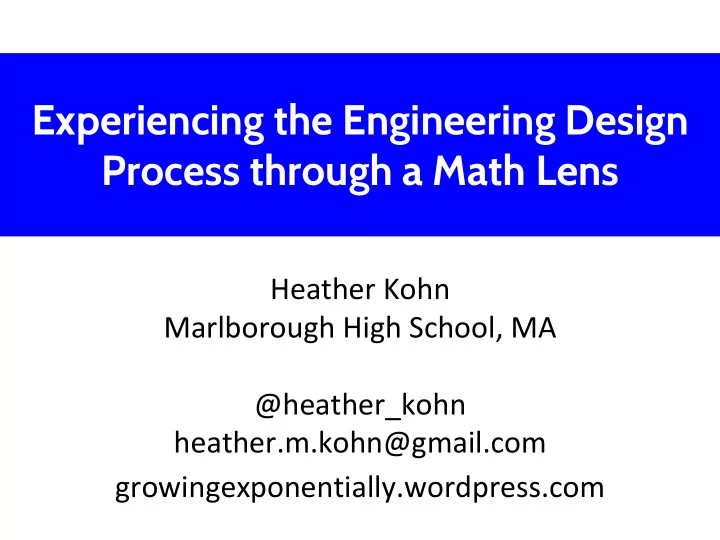

Experiencing the Engineering Design Process through a Math Lens Heather Kohn Marlborough High School, MA @heather_kohn heather.m.kohn@gmail.com growingexponentially.wordpress.com
Engineering Design Process
Engineering Design Process
Mindset We’re not doing engineering projects in math class. We’re doing math tasks with an engineering framework.
Why? “Design involves both the use of existing information and knowledge and the generation of new information and knowledge. Design requires leaps of the imagination, intuitive insight, the synthesis of different ideas, and empathy with people who come in contact with any new product, system, or process that is designed. Design is learned by doing and reflecting.” (Radcliffe, 2014)
Why? Math involves both the use of existing information and knowledge and the generation of new information and knowledge. Math requires leaps of the imagination, intuitive insight, the synthesis of different ideas, and empathy with people who come in contact with any new product, system, or process that is designed. Math is learned by doing and reflecting.
Processes Source: The Engineering Process in Construction and Design. (2013). Mathematics Teaching in the Middle School , 18 (6), 332-338.
Barbie Bungee Example Step 1: Identify the Challenge Design a bungee cord for Barbie that gives her the safest, but biggest thrill of a drop. Step 2: Research What do you need to know to solve this problem? Step 3: Develop Possible Solutions How many rubber bands do you think you should use? Why?
Barbie Bungee Example Step 4: Select the Best Solution What does the group think? Why? What materials will you need? Step 5: Construct a Prototype What is the procedure for building it? Step 6: Test and Evaluate the Solution How did Barbie’s bungee perform?
Barbie Bungee Example Step 7: Communicate the Solution How will you share your results? Step 8: Redesign How could you improve Barbie’s bungee?
Engineering Design Plan aka the “other” EDP
Catapult Launchers - Step 1 Challenge: Design a catapult that accurately launches an M&M so it hits the target Constraints: ● Time ● Materials ● “Budget” ● Wifi
Catapult Launchers - Step 2 Research: What do you already know about this problem? What do you need to know? What math do you need to know? At your table, you have 3 minutes to review the research cards, or do your own internet research on catapult design. Record any valuable information in your EDP.
Catapult Launchers - Steps 3 & 4 You have 5 minutes for these steps! Possible Solution: Sketch your own catapult design The BEST Solution: Chat with your group and select the best design. What materials will you need? [In addition to the supplies in your bag, there is: Gorilla Glue, duct tape, scissors]
Catapult Launchers - Steps 5 & 6 It’s building and testing time! You will have approximately 35 minutes to build, AND start testing your catapult. 2 parts to testing: 1 st = from ground 2 nd = from tabletop
Catapult Launchers – Step 6 a) Let’s say my averages are: Distance – 1.45 m Time – .813 sec b) .813/2 = 0.41 𝟑 𝟘. 𝟗 (𝟏. 𝟓𝟐) 𝟑 = 0.823 m 𝟐 c) 𝒆 = d) 1.45/2 = 0.725 m e) 𝟏 = 𝒃(𝟏 − 𝟏. 𝟖𝟑𝟔) 𝟑 +𝟏. 𝟗𝟑𝟒 𝒃 = −𝟐. 𝟔𝟕 𝒛 = −𝟐. 𝟔𝟕 𝒚 − 𝟏. 𝟖𝟑𝟔 𝟑 + 𝟏. 𝟗𝟑𝟒 f) 𝒛 = −𝟐. 𝟔𝟕 𝒚 − 𝟏. 𝟖𝟑𝟔 𝟑 + 𝟐. 𝟔𝟔
Catapult Launchers - Steps 7 & 8 Communicate Solution: Share your results with the whole group! Redesign: How could you improve your solution?
Other Tasks ● Barbie Zipline (Pythagorean Theorem) ● Amusement Park Rides (Circular Motion) ● Hotel Snap (Surface Area, Profit) ● Tinfoil Geometry (Surface Area) ● Make Your Own Visual Patterns (Functions) ● Bouncing Ball Investigation (Exponential) ● Mini Golf Hole Design (Angles, Reflection) ● Buried Treasure Maps (Triangle Congruence) ● Food Container Design (Geometry)
The math happens… whe hen n you u need d it it!! !!!
References Emerging Engineers Design a Paper Table. (2013). Mathematics Teaching in the Middle School , 18 (6), 362-369. Fosmire, M., and Radcliffe, D. F. (2014). Integrating information into the engineering design process . Purdue University Press. National Council of Teachers of Mathematics (NCTM). 2000. Principles and Standards for School Mathematics. Reston, VA: NCTM. The Engineering Process in Construction and Design. (2013). Mathematics Teaching in the Middle School , 18 (6), 332-338. Sweeney, Sean. (2009, Sept 1). M&M Catapult project pt. 2- The project [web blog post]. Retrieved from http://sweeneymath.blogspot.com/2009/09/m-catapult-project-pt- 2-project.html
Rate this presentation on the conference app! Search “ NCTM 2016 ” in your app store or follow the link at nctm.org/confapp to download Join in the conversation! #NCTMannual Download available presentation handouts from the online planner at nctm.org/planner
Recommend
More recommend